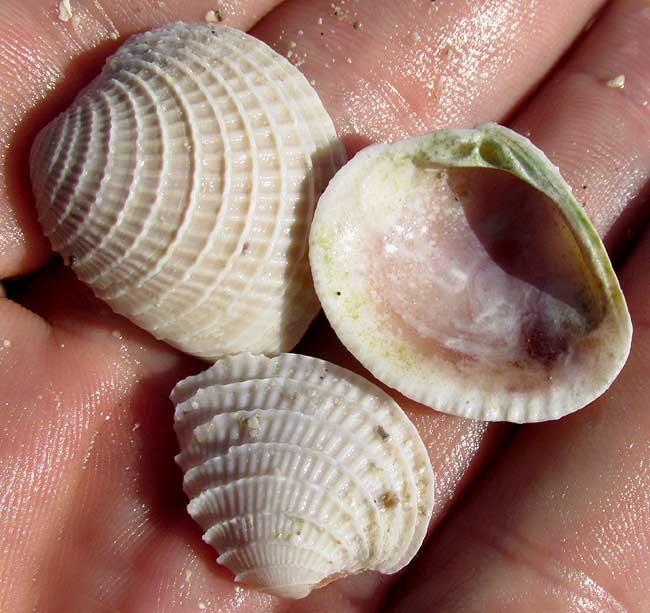Excerpts from Jim Conrad's
Naturalist Newsletter

from the January 25, 2015 Newsletter issued from Río Lagartos, on the Yucatan Peninsula's northern coast (~N21.60°, ~W88.16°), Yucatán state, MÉXICO
CROSS-BARRED VENUS CLAM SHELL
In the vast mud flats beside the salt-evaporation ponds of Las Coloradas, where the water is about ankle deep and much saltier than seawater, one of the common seashells turning up in the sand on the shore's edge is the one shown above.
Each of these shells constitutes just half of the armor of the original clam-like individual. The organism died, the tissue holding the two similarly shaped shells decayed, and now we have loose shells.
In the mud flat environment around Las Coloradas, untold numbers of white, similar-sized and similar-shaped shells litter the sand. At first they all look the same, but if you look closely you see that several species are represented. If you want to speak in general terms and aren't worried about an expert correcting you, with a sweep of the hand toward acres of exposed sand and shallow water you can refer generally to the collection of such white, clam-like shells as cockle shells. However, that term isn't technically acceptable for the shells in our picture.
For, in a narrow, technical sense, a cockle is a small, edible, saltwater clam in the mollusk family Cardiidae. The shells in our picture, however, were produced by a small, edible, saltwater clam in the mollusk family Veneridae, the Venus Clam Family. They're the Cross-barred Venus, CHIONE ELEVATA. Many of the most important edible species commonly known in the US as "clams" are members of this family.
Chione elevata is distributed from coastal North Carolina south to the Yucatan and Belize, and east to the Bahamas and Cuba. Only in the year 2000 was this species recognized as distinct from what is now regarded as a strictly Caribbean species, Chione cancellata, which also is known as the Cross-barred Venus. Though the evidence that two species are involved is pretty convincing, often Cross-barred Venus shells from our area are still labeled as Chione cancellata.
The reason I'm profiling this species instead of any other of the numerous, similar-looking species littering the salt flats of Las Coloradas is that this species is so distinctive that it's easy to identify. What's distinctive is the pattern of concentric, horizontal-running rings crossing the shell's vertical ribs, forming a crisscross pattern. Most Chione elevata shells are a little purplish inside, too.
Sometimes Cross-barred Venuses are present in abundance. A study in North Carolina found over ten individuals in each square meter of Shoal Grass. The species prefers shallow water in which seagrass grows, but it can survive in unvegetated areas, as at Las Coloradas.
Though Cross-barred Venuses are edible they're so small -- seldom exceeding 3cm (1-1/8in) -- that humans seldom bother with them. However, several kinds of mollusk, crab and fish feed on them, the clam's vulnerability to predation being aggravated by its tendency to be a shallow burrower in the mud.